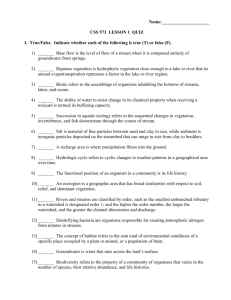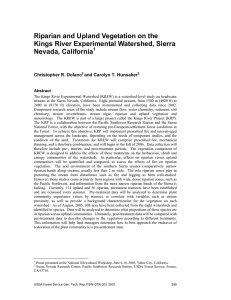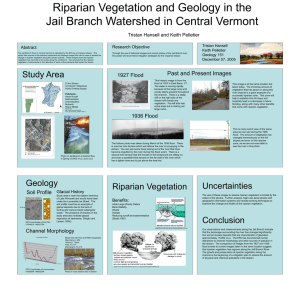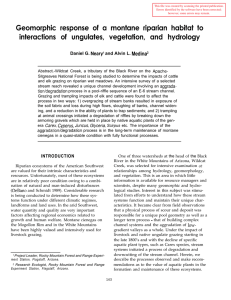A Comparison of Riparian Area ... with Large Scale Airphoto Interpretation
advertisement
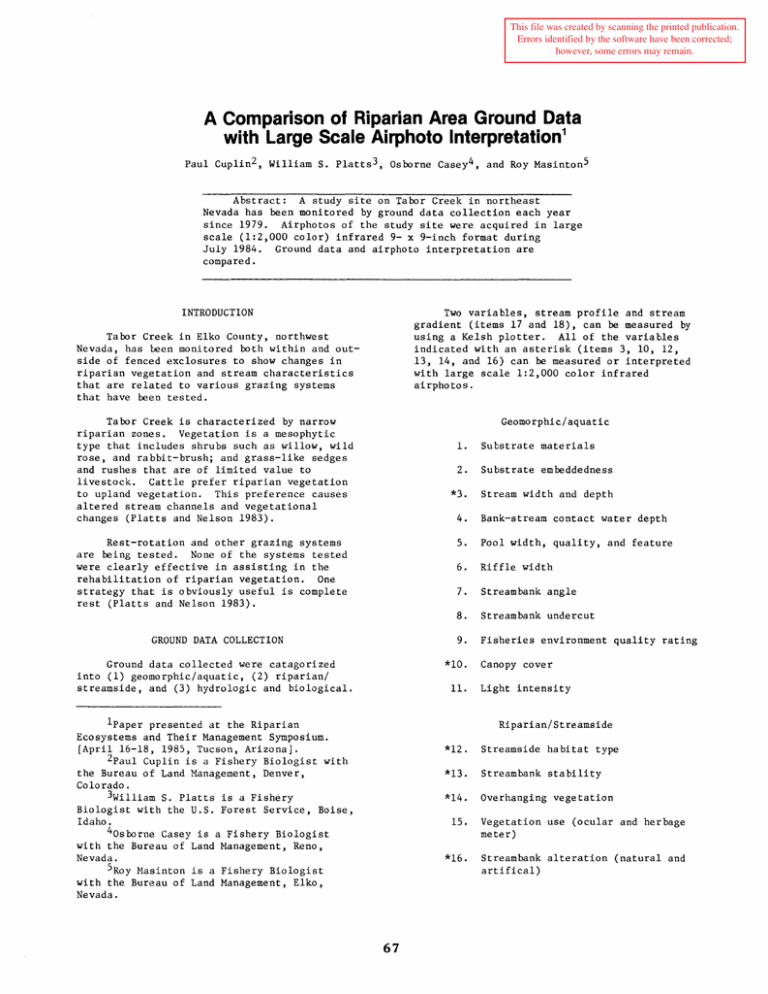
This file was created by scanning the printed publication. Errors identified by the software have been corrected; however, some errors may remain. A Comparison of Riparian Area Ground Data with Large Scale Airphoto Interpretation 1 Paul Cuplin2, William S. Platts 3 , Osborne Casey4, and Roy Masinton 5 Abstract: A study site on Tabor Creek in northeast Nevada has been monitored by ground data collection each year since 1979. Airphotos of the study site were acquired in large scale (1:2,000 color) infrared 9- x 9-inch format during July 1984. Ground data and airphoto interpretation are compared. INTRODUCTION Two variables, stream profile and stream gradient (items 17 and 18), can be measured by using a Kelsh plotter. All of the variables indicated with an asterisk (items 3, 10, 12, 13, 14, and 16) can be measured or interpreted with large scale 1:2,000 color infrared airphotos. Tabor Creek in Elko County, northwest Nevada, has been monitored both within and outside of fenced exclosures to show changes in riparian vegetation and stream characteristics that are related to various grazing systems that have been tested. Tabor Creek is characterized by narrow riparian zones. Vegetation is a mesophytic type that includes shrubs such as willow, wild rose, and rabbit-brush; and grass-like sedges and rushes that are of limited value to livestock. Cattle prefer riparian vegetation to upland vegetation. This preference causes altered stream channels and vegetational changes (Platts and Nelson 1983). Geomorphic/aquatic Rest-rotation and other grazing systems are being tested. None of the systems tested were clearly effective in assisting in the rehabilitation of riparian vegetation. One strategy that is obviously useful is complete rest (Platts and Nelson 1983). GROUND DATA COLLECTION Ground data collected were catagorized into (1) geomorphic/aquatic, (2) riparian/ streamside, and (3) hydrologic and biological. 1. Substrate materials 2. Substrate embeddedness *3. Stream width and depth 4. Bank-stream contact water depth 5. Pool width, quality, and feature 6. Riffle width 7. Streambank angle 8. Streambank undercut 9. Fisheries environment quality rating *10. 11. lPaper presented at the Riparian Ecosystems and Their Management Symposium. [April 16-18, 1985, Tucson, Arizona]. 2Paul Cuplin is a Fishery Biologist with the Bureau of Land Management, Denver, Colorado. 3William S. Platts is a Fishery Biologist with the U.S. Forest Service, Boise, Idaho. 40sborne Casey is a Fishery Biologist with the Bureau of Land Management, Reno, Nevada. 5Roy Masinton is a Fishery Biologist with the Bureau of Land Management, Elko, Nevada. Canopy cover Light intensity Riparian/Streamside 67 *12. Streamside habitat type *13. Streambank stability *14. Overhanging vegetation 15. Vegetation use (ocular and herbage meter) *16. Streambank alteration (natural and artifical) Hydrologic and biological 17. Stream profile 18. Stream gradient 19. Stream volocity 20. Fish species composition, number, and biomass base with more information than either method would provide separately. Airphotos can be used for monitoring change. The technique is to visually compare baseline airphotos with airphotos taken about five years later. If obvious changes are apparent, sample areas can be delineated and compared. If significant changes have occurred, field data collection will help determine the cause of change. In addition to the variables indicated above, ground cover of trees, shrubs, and herbaceous vegetation; bare soil; riparian area acreage; and structure can be determined. LITERATURE CITED Platts, William S., and Rodger Loren Nelson. 1983. Livestock-Fishery interaction studies, Tabor Creek, Nevada. USDA Forest Service, Intermountain Forest and Range Experiment Station. 73 pp. Boise, Idaho. CONCLUSIONS Ground data collection and large scale CIR airphoto interpretation provide a combined data 68



